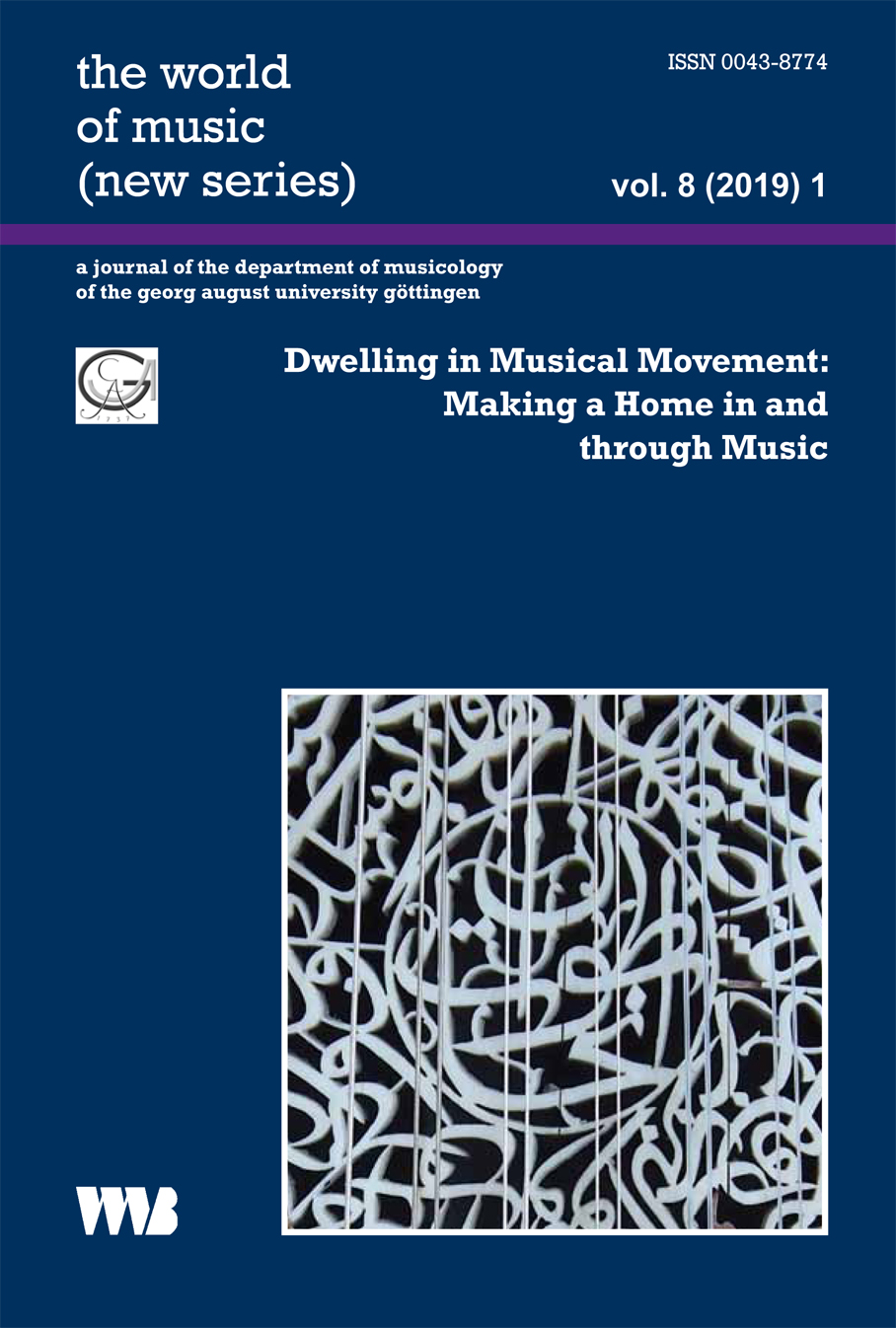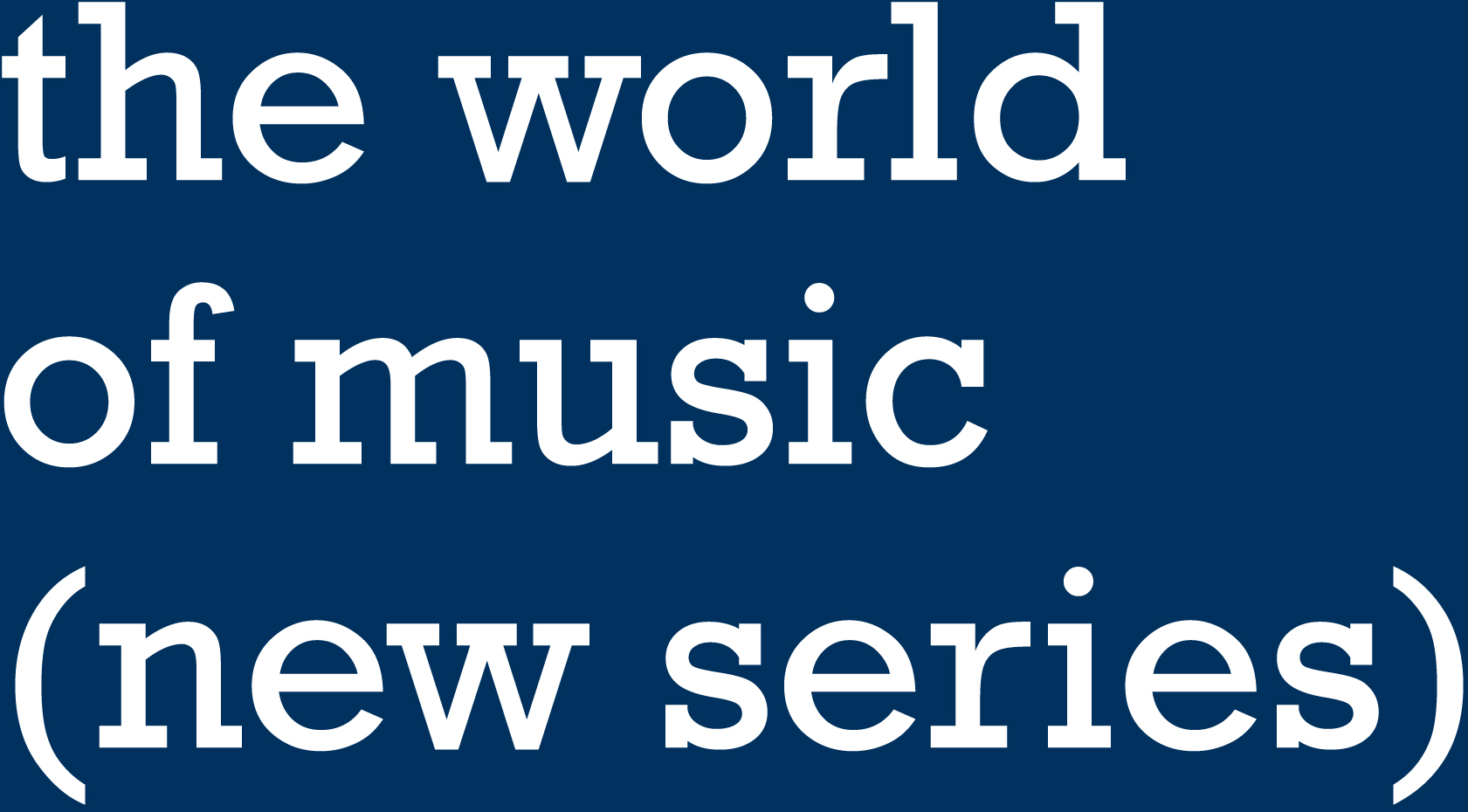Dwelling in Musical Movement:
Making a Home in and through Music
the world of music (new series) volume 8, issue 1 (2019)
Guest Editor: Barbara Titus
.:: Table of Contents
Introduction: Dwelling in Musical Movement
Barbara Titus
Orientation through Instruments: The oud, the Palestinian Home, and Kamīlyā Jubrān
Rachel Beckles Willson
A Poetics of Dwelling with Music and Dance: Le hip hop as Homing Practice
Birgit Abels
States of Play/ing: Sonic Dwellings on a Music Tour
Anna Lisa Ramella
Making Pathways while Walking and Singing in Shimshal Valley, Pakistan
Thibault Fontanari
Book Reviews (Eva-Maria Alexandra van Straaten, ed.)
Robert B. Winans (ed.), Banjo Roots and Branches. (2018)
Scott V. Linford

Nancy Yunhwa Rao, Chinatown Opera Theater in North America. (2017)
Dongshin Chang
Robert Lachmann & Ruth Davis (eds.), The “Oriental Music” Broadcasts 1936–1937—A Musical Ethnography of Mandatory Palestine. (2013)
Eric Petzoldt
Andrew Martin, Ray Funk, & Jeannine Remy, Steelpan in Education: A History of the Northern Illinois University Steelband. (2017)
Charissa Granger
Frederick Lau & Christine R. Yano (eds.), Making Waves: Traveling Musics in Hawaiʻi, Asia, and the Pacific. (2018)
Brian Diettrich
Jonathan Dueck, Congregational Music, Conflict and Community. (2017)
Marissa Moore
Andrew N. Weintraub & Bart Barendregt (eds.), Vamping the Stage: Female Voices of Asian Modernities. (2017)
Megan Jane Sinnott
Lori Burns & Steven Lacasse (eds.), The Pop Palimpsest: Intertextuality in Recorded Popular Music. (2018)
Anna-Elena Pääkkölä
Frank Gunderson, The Legacy of Tanzanian Musicians Muhidin Gurumo and Hassan Bitchuka. Rhumba Kiserebuka! (2018)
Werner Graebner
Gerhard Kubik, Jazz Transatlantic, Volume I: The African Undercurrent in Twentieth-Century Jazz Culture; Jazz Transatlantic, Volume II: Jazz Derivatives and Developments in Twentieth-Century Africa. (2017)
Mischa van Kan
Recording Reviews (Rehanna Kheshgi, ed.)
The Groove Is Not Trivial. Verite Productions. Directed by Tommie Dell Smith. (2016)
Kathryn Alexander
Teruhisa Fukuda. Japan: Musical Offering of a Shakuhachi Master. Produced by the Musée d’ethnographie de Genève. (2018)
Kiku Day
Gochag Askarov and Pierre De Trégomain. Mugham Souls. Felmay Records. (2017)
Polina Dessiatnitchenko
Laos: Musique des Khmou. Recorded by Véronique de Lavenère. Produced by the Musée d’ethnographie de Genève. (2017)
Joe Kinzer
.:: Individual Paper Abstracts
Introduction: Dwelling in Musical Movement
Barbara Titus
In order to articulate possible dynamics of dwelling in and through music, this introductory essay searches for conceptual tools that can help us articulate how music and sound re/organize space. This search is centralized around an autoethnographic account of me dwelling (in having learned) a South African maskanda vocal technique, and the employment of Catherine Malabou’s notion of plasticity as a double movement of giving and receiving form (2000:203). From this perspective, I introduce the four articles that constitute this themed issue by commenting on the theoretical frameworks they employ—notably by Sara Ahmed, Tim Ingold, Brandon LaBelle and Erin Manning. Drawing on work by Ana María Ochoa Gautier and Gavin Steingo, I argue that (musical and sonic) dwelling presupposes not only an engagement with the world, but also a (temporary) detachment from the world that enables this engagement in the first place.
Orientation through Instruments: The Oud, the Palestinian Home, and Kamīlyā Jubrān
Rachel Beckles Willson
This article examines ways that the oud, the most fundamental instrument of Arab traditions, may foster, shape and complicate notions of home. A central claim is that this instrument provides a rich vehicle through which to examine the dynamics of “homing processes” (Ahmed et al. 2003) in both domestic and national settings. The argument draws on Sara Ahmed’s theory of “orientation” (2006), setting the work of Palestinian Kamīlyā Jubrān in the context of gendered musical traditions in the Arab world, and interweaving it with the author’s own attempt—as a stranger—to learn the oud. The interwoven sources prompt consideration of the way that an instrument can be used to generate resistance to hegemonic knowledge and create spaces for exploring modes of dwelling that are not defined by patriarchal and/or colonial boundaries.
A Poetics of Dwelling with Music and Dance: Le hip hop as Homing Practice
Birgit Abels
In this article, I suggest that the transitory and, to a significant extent, disciplined techniques of music and dance can be used towards a flexing of the lived experience. Such flexing invites an intensification of the sensation of being in the world which, in turn, allows those partaking in music and dance to make the world their own through sound and body movement. Music and dance, therefore, are dwelling practices themselves. As such, they do not represent or occupy time and space. Instead, they become strategies of (felt-)bodily practicing and rearranging time and space rather than merely representing them. This capacity of music and dance vis-à-vis everyday life worlds accounts for their significance in everyday life. Here, I explore music and dance as dwelling practices through the work of the French dance duo Les Twins. Casting light on the role of music and dance in making a home in the world, I will approach the dynamics of Les Twins’s dwelling with music and dance through the experiential, the moving and the relational.
States of Play/ing: Sonic Dwellings on a Music Tour
Anna Lisa Ramella
This article considers two issues: what happens in the nexus of sound and place during a live performance and while setting up, and what is the effect of sound on the experience of time and place of touring musicians. I explore the significance of musical performance through an investigation of the sonic environment (Edensor 2011) in a music venue as a process of attunement (Stewart 2011, Wallrup 2015). Based on ethnographic fieldwork on tour with several rock bands, I analyse the role which practices of stage set-up, soundchecking and instrument tuning—in addition to the musical concert performance itself—play as constituent elements of place-making on the move. Drawing on notions of both play (Csikszentmihalyi & Bennett 1971) and dwelling (Ingold 2011), I frame my ethnographic data with a specific focus on the emplacing capacities of sonic practices with the aim of understanding the effects which playing music has on the experience of touring.
Making Pathways while Walking and Singing in Shimshal Valley, Pakistan
Thibault Fontanari
This article explores the way in which the inhabitants of Shimshal Valley in the Karakoram (Pakistan) make their home in the world by praising and singing while walking. I start my narrative by describing how people position themselves socially, both at home and on the road. Two episodes follow. The first one depicts a collective action in which the villagers open up a road obstructed by falling stones. The second episode is about the singing of a poem by a shepherd during a journey to the summer pastures. Through a phenomenological approach I seek to understand how the sonic dimension of collective actions frames a shared place and generates the matrix from which praise songs are composed. These songs are sung during the walk and gather people together in a shared place, in addition to generating a melodic line as a pathway on which listeners walk.

